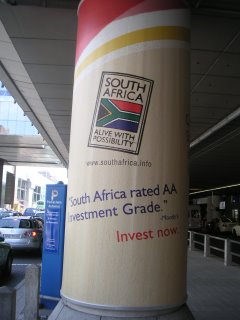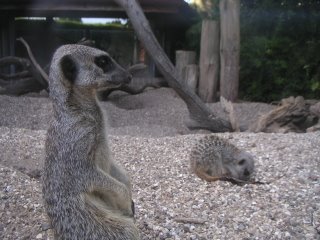Finally! I'm now in Cape Town. And I'm in an internet cafe!
 My current view
My current viewI'm just glad I've reached Cape Town safe and sound. My original flight path was to fly from Heathrow to Frankfurt and then on to Cape Town with Lufthansa. However, the flight from Heathrow was delayed for 1 hour, causing me to miss the connecting flight to Cape Town. Hence I spent a night in a hotel in Frankfurt at the courtesy of Lufthansa.
 Advert at Frankfurt International
Advert at Frankfurt InternationalThe next day I had to take a flight to Paris, and then from Paris to Johannesburg with Air France, followed by a domestic flight to Cape Town with South African Airways. And sadly enough, all these troubles were caused by Heathrow's ageing systems and poor planning. I've been through quite a few airports during this journey...Heathrow, Frankfurt International, Paris Charles de Gaulle, Johannesburg International, Cape Town International....and I've to say that Heathrow is the worst of the lot. Poor planning, old systems, and inadequate ventilation led to long queues and rising temperatures (both literally and metaphorically). All the other airports were made of shiny metal and glass, very modern and contemporary. While Heathrow is just a grey lump of concrete shit. It beggars belief, considering that it is one of the largest airports in the world...
 South African hospitality!
South African hospitality!Anyway, enough of me bitching about airports. Cape Town is a magnificent city, dominated of Table Mountains. It is winter now. The weather at the moment is.....fresh is the word that comes to mind. It is not cold (temperatures are around 18 deg C in the day and around 4-5 deg C at night). It is very green at the moment. Trees and grasses are growing every where due to the rains. Due to Cape Town being at the coast, the fog from the seas blow inshore into the city in the early morning, and by noon, the sun burns it up, leaving it clear and bright. It feels like a coastal city in America (eg California, Miami) with wide boulevards and multi-million beach front properties.
 Table Mountains dominate the sky line
Table Mountains dominate the sky lineHowever, all is not bright and white (pun not intended) in Cape Town. Just a few kilometers out from the airport on the way to town, I pass by slums where poor Africans live. And in the city itself, it is dangerous to hang around at night. The street kids take over and they can snatch wallets and cameras from you.
 City Hall, with cloud-covered Table Mountains in the background
City Hall, with cloud-covered Table Mountains in the backgroundI was taking some pictures of the City Hall, where a street market in its parking lot was being taken down for the day, when a lady (I later found out that she was the market manager) told me to be careful as the kids might snatch my camera away. She was telling me to go home and come back on a weekday as the kids take over the streets after 5pm on the weekends (and it was 4.45pm already!).
 Armed security
Armed securityRest assured, I reached my hostel safe and sound. Houses here are alarmed, protected by razor wire (some be electric fences) and guarded by armed security personnel. I've been to quite a few places in my life, and I do definitey get a vibe that some areas here are really not safe to be traveling alone.
 Razor wire
Razor wireApart from crime, things here are slightly cheaper than Bristol. Food is excellent and really cheap! The oranges are huge and filling! People are generally friendly and welcoming (could they be thinking that I'm a rich tourist?). You can find street markets in the city centre selling African handicrafts to local food and fruits.

 Street market
Street marketOn Tuesday, I shall be starting my White Shark placement in Gaansbaai (about 2 hours drive from Cape Town). Hopefully, I'll have some really great pictures to post here soon!
 "Wellekom! Wellekom to Afriika! Give me monie! Thank you!"
"Wellekom! Wellekom to Afriika! Give me monie! Thank you!"

 Street market
Street market




















